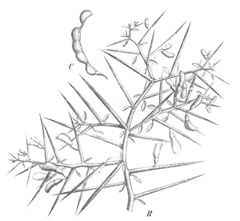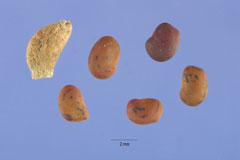 |
|
http://commons.wikimedia.org/wiki/File:Alhagi_maurorum_Taub123b.png |
 |
|
Translate this page:
Summary
Physical Characteristics

 Alhagi maurorum is a deciduous Shrub growing to 2 m (6ft 7in).
Alhagi maurorum is a deciduous Shrub growing to 2 m (6ft 7in).
See above for USDA hardiness. It is hardy to UK zone 7. It is in flower in July. The species is hermaphrodite (has both male and female organs).
It can fix Nitrogen.
Suitable for: light (sandy) and medium (loamy) soils and prefers well-drained soil. Suitable pH: mildly acid, neutral and basic (mildly alkaline) soils and can grow in saline soils.
It cannot grow in the shade. It prefers dry or moist soil.
UK Hardiness Map
US Hardiness Map
Synonyms
A. camelorum. A. persarum. Hedysarum pseudalhagi.
Plant Habitats
Cultivated Beds;
Edible Uses
Edible Parts: Manna
Edible Uses:
A sweet-tasting manna is exuded from the twigs at flowering time[2, 22, 105, 177]. It is exuded during hot weather according to one report[1]. It contains about 47% melizitose, 26% sucrose, 12% invert sugar[114]. Another manna is obtained from the pods - it is sweet and laxative[61]. Root - cooked. A famine food, it is only used in times of need[46, 61, 177].
References More on Edible Uses
Medicinal Uses
Plants For A Future can not take any responsibility for any adverse effects from the use of plants. Always seek advice from a professional before using a plant medicinally.
Diaphoretic Diuretic Expectorant Laxative
The whole plant is diaphoretic, diuretic, expectorant and laxative[46, 114]. An oil from the leaves is used in the treatment of rheumatism[238]. The flowers are used in the treatment of piles[238].
References More on Medicinal Uses
The Bookshop: Edible Plant Books
Our Latest books on Perennial Plants For Food Forests and Permaculture Gardens in paperback or digital formats.

Edible Tropical Plants
Food Forest Plants for Hotter Conditions: 250+ Plants For Tropical Food Forests & Permaculture Gardens.
More

Edible Temperate Plants
Plants for Your Food Forest: 500 Plants for Temperate Food Forests & Permaculture Gardens.
More

More Books
PFAF have eight books available in paperback and digital formats. Browse the shop for more information.
Shop Now
Other Uses
References More on Other Uses
Cultivation details
Requires a sunny position in a well-drained light or medium soil. Plants are not very hardy in Britain, they can be grown outdoors in the summer but require protection in the winter[1]. The stems of the plant are covered in sharp spines[245]. Like the closely related gorse (Ulex europaea) the flowers have a pineapple scent[245]. (A slightly strange report because the gorse flowers have a strong coconut fragrance[K].) This species has a symbiotic relationship with certain soil bacteria, these bacteria form nodules on the roots and fix atmospheric nitrogen. Some of this nitrogen is utilized by the growing plant but some can also be used by other plants growing nearby[200].
References Carbon Farming Information and Carbon Sequestration Information
Temperature Converter
Type a value in the Celsius field to convert the value to Fahrenheit:
Fahrenheit:
The PFAF Bookshop
Plants For A Future have a number of books available in paperback and digital form. Book titles include Edible Plants, Edible Perennials, Edible Trees,Edible Shrubs, Woodland Gardening, and Temperate Food Forest Plants. Our new book is Food Forest Plants For Hotter Conditions (Tropical and Sub-Tropical).
Shop Now
Plant Propagation
Seed - pre-soak the seed for 12 hours in warm water and sow March/April in a warm greenhouse. When large enough to handle, prick the seedlings out into individual pots and grow them on in a greenhouse for at least the first winter. Plant out into their permanent positions in the summer. Cuttings of young shoots in a frame[1].
Other Names
If available other names are mentioned here
Native Range
TEMPERATE ASIA: Kuwait, Afghanistan, Cyprus, Iran, Iraq, Israel, Jordan, Lebanon, Syria, Turkey, Russian Federation-Ciscaucasia (Ciscaucasia), Armenia, Azerbaijan, Russian Federation (Dagestan), Russian Federation-Western Siberia (Western Siberia (south)), Kazakhstan, Tajikistan, Turkmenistan, Uzbekistan, Mongolia, China (northwest) TROPICAL ASIA: India (north), Pakistan EUROPE: Russian Federation-European part (European part (south))
Weed Potential
Right plant wrong place. We are currently updating this section.
Please note that a plant may be invasive in one area but may not in your area so it's worth checking.
A. maurorum and one or more of its synonyms are listed as a noxious weed in seven states of USA and it has been declared a state prohibited weed in Victoria, Australia and a regulated invasive species in South Africa. A. maurorum has been introduced as contaminant of fodder and spread by livestock. It is a most hardy and aggressive species and it is very difficult to eradicate and manage the established populations because of its extensive root system.
Conservation Status
IUCN Red List of Threatened Plants Status : This taxon has not yet been assessed.

Growth: S = slow M = medium F = fast. Soil: L = light (sandy) M = medium H = heavy (clay). pH: A = acid N = neutral B = basic (alkaline). Shade: F = full shade S = semi-shade N = no shade. Moisture: D = dry M = Moist We = wet Wa = water.
Now available:
Food Forest Plants for Mediterranean Conditions
350+ Perennial Plants For Mediterranean and Drier Food Forests and Permaculture Gardens.
[Paperback and eBook]
This is the third in Plants For A Future's series of plant guides for food forests tailored to
specific climate zones. Following volumes on temperate and tropical ecosystems, this book focuses
on species suited to Mediterranean conditions—regions with hot, dry summers and cool, wet winters,
often facing the added challenge of climate change.
Read More
Expert comment
Author
Medik.
Botanical References
193
Links / References
For a list of references used on this page please go here
Readers comment